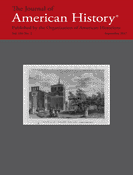-
Views
-
Cite
Cite
Alexandra Finley, “Cash to Corinna”: Domestic Labor and Sexual Economy in the “Fancy Trade”, Journal of American History, Volume 104, Issue 2, September 2017, Pages 410–430, https://doi.org/10.1093/jahist/jax174
Close - Share Icon Share
Extract
From 1856, the year she learned to write, until 1867, Corinna Hinton signed her name Mrs. Corinna Omohundro. Though she claimed the title for herself, the law did not recognize her as Mrs. Omohundro. She was never legally married to the father of her children, the Richmond slave trader Silas Omohundro. In fact, under Virginia law, Corinna Hinton could not even enter into marriage. Corinna Hinton was enslaved.1
The man who owned Corinna was also the man she claimed as her husband, Silas Omohundro. From the time she was around fourteen years old until Silas's death in 1864, Corinna was simultaneously the mother of his children and his enslaved property. Like many slave traders, Omohundro throughout his life selected concubines from among the young enslaved women he purchased. He relied on these women, particularly Corinna, for domestic and reproductive labor. Omohundro profited from Corinna not through commodifying her sexuality on the auction block, but by exploiting her domestic and sexual labor within his own household, boardinghouse, and slave jail (a place where slave owners and traders could board their slaves for a fee). As an enslaved woman assisting in the management of a slave jail, Corinna was both victim of and contributor to the mass sale of enslaved men, women, and children from the upper South to the lower South, a trade that would force the movement of 200,000 slaves, on average, each decade between 1820 and 1860.2





